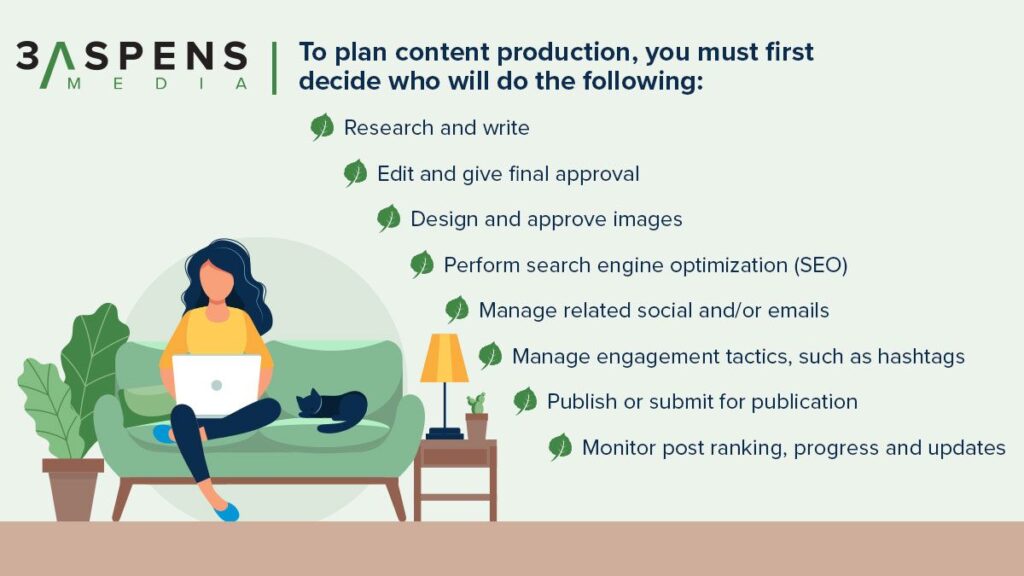“Don’t you just type whatever comes to mind, send it into the universe and then collect the rewards?” your well-meaning relative may ask at a Sunday dinner.
No. No, you do not.
So, what is content production, and why is it important to create a strategy and processes around it?
Content production is an ongoing conversation that extends across all your assets – copy, graphics, social posts, ebooks, case studies and anything else produced by your rock-star marketing team. It’s a lot to juggle, especially for a marketing team of one.
How do you organize this process that feels like wrangling cats?
You must strategize around scheduling, resource planning and, ultimately, how you’ll execute everything.
Creative content production takes up valuable time and resources. And it’s worth it. But if careful planning and organization aren’t behind the creativity, you won’t get the maximum return you’re looking for from your content strategy.
Let’s review the organizational side of delivering a content strategy and how advanced planning and a set structure will save you headaches, hassle and a lot of stress.
Determine Realistic Content Deliverables
Let’s say you’ve already analyzed your content pillars and strategies. Now, you must decide how to get your brilliant plans out into the universe. This is the heart of your content production strategy. At this stage, set yourself up for success by paring down to what you know you can realistically deliver.
For example, you may read that you must post 15 social posts a week at various times that all tie into your weekly blog post, which features your TikTok video and also includes a link to your YouTube channel.
Going from nothing to this schedule is like learning about what a hammer is one week and building a 25,000-square-foot house the next. You will burn out and abandon your schedule and all the gold nuggets of content you had planned before anyone has the chance to discover them thanks to your clever, thoughtfully researched hashtags.
Questions to ask yourself:
- How often will you post content to your blog (aka resource library)?
- Have a set list of topics to get your writing going. This is also known as your editorial calendar.
- Will you incorporate other content assets, such as ebooks or case studies? Make sure you know your processes.
- Are emails part of your strategy?
- How often will you commit to sending emails?
- What will you promote?
- Do you have a distribution list, or do you need to create one?
- What social media outlets will content be promoted on? How many posts per week?
Remember, the answers to these questions need to be realistic. There is nothing wrong with starting small and reevaluating your plan at the start of each quarter. If weekly social posts seem like too much, start with a minimum plan of twice a month and build from there. Start with newsletters every other month before you commit to monthly.
You want to commit to consistently delivering high-quality content instead of high-quantity, low-quality content that misses the mark. If it’s just noise, don’t publish it.
Design Your Content Production Workflow
A solid content strategy requires a solid production strategy. Afterall, an idea is nothing if there is no execution behind it. Now that you have a top-ranking blog idea, you must have a plan to get it from your brain to a reader’s line of sight.
Let’s state the obvious: It’s a lot to coordinate. If you went through this process and named the same person for everything, then make sure you’re not aiming to publish a post daily. This helps ensure quality.
Content Tip: Repurposing isn’t cheating. You can break a blog post up into multiple bites of digestible information for a social campaign. You can include the same information from this blog post in an ebook as well as a leave-behind for your sales team. The goal is to get your best information out to as broad an audience as possible. The person who sees your social may not be the same person who reads your brochure. Simplify your life and reuse assets in as many forms as possible.
Use Content Production Tools for Organization
Even if you are a team of one, your team needs a system to keep track of moving parts. It does not matter if that’s a straightforward traditional process, like an Excel spreadsheet or a printed list you can cross things off, or a more modern project management board such as Asana, Trello or Wrike. The goal is to find out how you and your team works best and find a process that is easy to tweak and scale as your content soars and business picks up.
At 3 Aspens, we have a dedicated content production team. Each member has different responsibilities, but we collaborate and communicate throughout the creation of each content piece. Given that our team spans across the country, working remotely, we also use Trello and Slack to make sure communication and status updates are immediately available.
You should also be clear and firm on your internal deadlines. Set deadlines when everything must be finished and then work backward. Working backward when developing a timeline will give you the best idea of when each phase of a project for your content needs to be completed to move forward to the next step without hang-ups. (There will be other hang-ups because that is the nature of projects, but it won’t be because of the timeline thanks to your amazing planning.)
You can tweak all of this as you go. But you need a foundation before you can start tweaking. Adjust what doesn’t work right away. Analyze the process after each quarter and as your team and business grows.
Have a Content Project Manager (aka Cat Wrangler)
Going back to who manages what – you need a content manager to organize and execute the content production process.
Just as theater productions cannot happen without a dedicated and knowledgeable stage manager organizing the creativity to ensure the director’s clear vision is front and center, a content strategy needs a production strategy with a content manager at the helm to ensure success. This content manager may be internal or external depending on your resources.
Your content manager double checks the editorial calendar, checks in with design and makes sure that the process is as streamlined as possible. This person also gathers resources – like scheduling subject matter expert (SME) interviews to help the writer add depth and expertise to the piece.
The content manager will keep your editorial calendar on schedule and ensure every aspect of content adheres to the brand – both in voice and design. Brand consistency is key so prospects can immediately recognize your content across your assets. Switching brand colors and fonts every week will just confuse the messaging.
If you decide you need to outsource your content manager, or any other aspect of your content, make sure you are partnering with someone who both knows your industry and lives and breathes content creation.
Avoid Content Cat-astrophes – Planning and Execution is Key
Content creation involves creativity, both in the creation and execution. You need to know where you are at with your resources and where you’re going with your brand. It’s a lot to manage.
But do you know what else content creation is? It’s fun and rewarding.
Fun just like a viral cat video
Once you do the work to put together your content strategy and plan, you’ll realize that the execution and organization aspect requires just as much, if not more effort. Like we said before, if you write content and put it out in the universe without keyword and hashtag research, will anyone read it? Probably not.
At 3 Aspens Media, we pride ourselves in the execution of our clients’ visions and bringing content in front of their audiences. Feel free to reach out to our team for additional resources and support. The only thing we love more than content creation is helping others in the industry.
And sign up for our newsletter, Roots and Branches, to get the latest tips of content creation and production.






